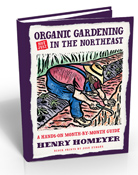Keeping the Deer at Bay, the Weeds at an Arm’s Length
Karen Gillock and her husband, Rick Simons, live near the end of a dead-end dirt road in Cornish, NH. Karen has a big vegetable garden with 3 dozen tomato plants and much more. The garden allows them to eat fresh produce all summer and put up a year’s worth of tomato sauce each fall. Because she has a busy professional life, Karen has devised systems to produce her summer’s bounty with a minimum of effort – and to protect it from a forest full of hungry deer.

wood-sided raised beds
This spring Karen decided to install wood-sided raised beds, each 3- by 8-feet. That’s a nice size: she can reach the middle of a bed from either side without straining. She had the beds made using rough-sawn hemlock obtained from a local saw mill. The boards for the beds are a full 2- by 8-inches. Hemlock is quite resistant to rot, and with luck should last 8 to10 years. Pine will work, but won’t last as long. Pressure treated wood should be avoided as toxins from it may leach into the soil.

landscape fabric to cover each bed
Weeding is not one of Karen’s favorite pastimes. For years she has spread black landscape fabric over her entire garden to exclude the weeds, just slicing the fabric as needed to make room for her plants. This year, with the new wood beds, she has had to modify the arrangement slightly, cutting landscape fabric to cover each bed. Rick ordered a roll of good quality landscape fabric (one you cannot tear and that is rated for 15 years of use outdoors). The fabric allows rain to penetrate, but no sun – which keeps out the weeds.
Karen had the beds filled with her garden soil and enriched it with extra compost. A tractor with a bucket did the job in just a few hours (instead of days of back-breaking labor that would be required to do it by hand). Then, with a helper, she stretched the landscape fabric over the beds and stapled it in place, carefully folding the fabric on the corners the way you might wrap a present. Her stapler is the kind used by builders for installing insulation, not an office type.
To plant the beds, Karen sliced through the fabric, cutting a row or open square big enough to insert the plants or seeds. This fall she will use duct tape to close the slits and next year will plant into different places.
For some plants – lettuce for example – weeds never had a chance. As the plants got bigger, they shaded out any daring young weeds. Others, such as her prize tomatoes, had enough space to grow a few weeds, too, but many fewer than if she had just planted them uncovered in the ground. Another advantage of the fabric: some tomato blights are soil-borne and infect plants when the spores splash up onto the lower leaves. The fabric should minimize that splash-up, though some blight is air-borne, so it’s not a sure preventive for blight.
Then there are the deer. Instead of fencing the entire garden, Karen decided to build shields over some beds with veggies that appeal to deer. Deer always go for her lettuce, chard and – this year – they have gone after peppers and broccoli, too. But her tomatoes have never been bothered by her deer, nor have they eaten her herbs, onions, cucumbers or squash.

Protecting plants from deer
Rick got her a roll of 4-foot wide welded steel fencing (with 2-inch openings) and a roll of 2-foot wide fencing (with 1-inch openings). Using tins snips, Karen cut 7-foot lengths of fencing and arched them over the 3-foot wide beds. Each bed needed 2 pieces of the 4-foot wide fencing to cover its 8-foot length. She used plastic tie-wraps to attach the two pieces of fencing side-by side. It is heavy enough that it doesn’t flop or bend, but stands up nicely and can be lifted off for harvesting. Karen used the 2-foot wide fencing to make end pieces to keep the dome structurally sound and to prevent enterprising deer from sticking their heads inside to grab a bite of her lettuce.
With left over fencing Karen surrounded the beds that were not covered with domes that might be of interest to deer. She was surprised when the deer walked into the enclosed section of garden – she had left just a small open “doorway” so that she could get in herself. Lesson learned: hungry deer are not afraid of walking into small enclosures if they see something they want. So she surrounded those beds with 4-foot fencing attached to grade stakes, right next to the beds. The beds are small enough that deer haven’t jumped over the fence to get inside such tight quarters.
The best arrangement I’ve ever seen for thwarting deer was at Fort Ticonderoga. There is a vegetable garden that is protected (after the tourists go home) with an electric horse fence. It is one that could easily be jumped by deer, but the deer are afraid of it. Each night workers spread peanut butter on squares of aluminum foil, attach the squares with clothes pins, then turn on the fence. Deer come, attracted to the smell of peanut butter. The smart deer just taste the electrified peanut butter once. The dummies learn more slowly, but never cross the fence. It must give them quite a jolt.


